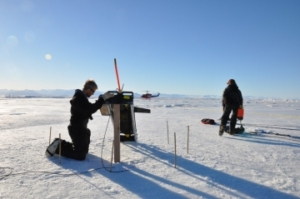Researchers at Old Dominion University’s Center for Coastal Physical Oceanography (CCPO) are studying how floating ice sheets melt in three Arctic locations. Using ocean circulation models, they are observing how ocean water inundates the base of the ice sheets, causing them to melt. The research is being conducted by John Klinck, director of CCPO, and two research scientists from Old Dominion’s Research Foundation, Mike Dinniman and Pierre St-Laurent.

Dinniman deploying research equipment at the edge of the Ross ice shelf.
The team is conducting their research in three locations, including the Antarctic Peninsula, the Ross Sea, and the Amundsen Sea, where glaciers are melting dramatically. In fact, some glaciers in their research area are retreating up to 30 feet annually. Once ocean water gets under the glaciers, they tend to melt faster, contributing to sea level rise across the globe.
Sea level rise has had damaging affects in Hampton Roads region, near the mouth of Chesapeake Bay. Melting glaciers account for a third of sea level rise in our area, which could have devastating effects for coastline ecosystems. Klinck is concerned that sea level rise in the Bay “increases the number of times in a year that we have flooding events.” The team hopes that this research will help inform global climate models that do not currently include ice shelves.
This research was recently featured on ODU’s news page.
